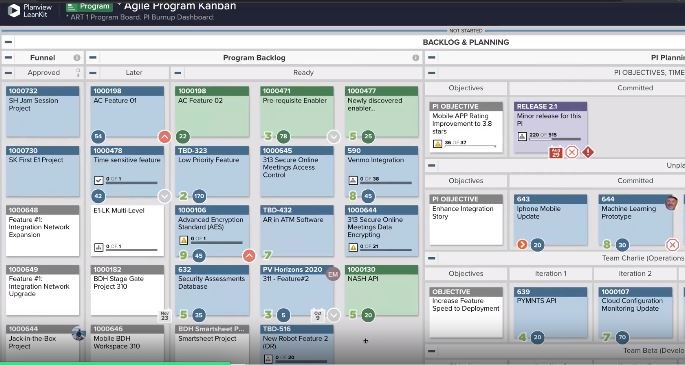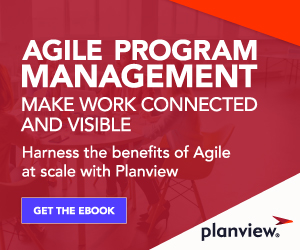
If you’re familiar with scaling Agile, you’ve probably heard of the Agile planning practice known as Program Increment (PI) planning. But not all companies use the name PI Planning. Others refer to as Big Room Planning, Big Board Planning, Mid-Range Planning, or Quarterly Planning. No matter what you call it, many companies have found substantial value when applying this type of planning to their Agile program. The objective is the same. Get your Agile teams together to collaborate, communicate, and plan the value that must be delivered in the coming quarter.
We recently hosted a series of virtual discussions complete with demos that outline how establishing Agile Program Management can help organizations tackle the biggest challenges with scaling Agile. In this four-part blog series, I share highlights from each discussion offering ways to improve your approach to scaling Agile.
This blog is dedicated to discussing Part 2: “Agile Planning – Let’s Plan the Plan” and focuses 4 ways to leverage Planview AgilePlace for PI Planning.
If you are eager to learn more, here’s easy access to the complete Agile Program Management 4-Part discussion and demo series. I hope you find the content helpful.
What is PI/Quarterly Planning?
At Planview, we’ve been doing PI Planning for going on two years. To summarize, PI Planning brings together teams of teams or Agile Release Trains (ARTs) (in person, or virtual) to collaborate and set a vision for what will be delivered during a 10-12-week increment. At the onset, leadership provides business context and vision. Teams then work together to prioritize epics and align everything to organizational goals and objectives. The outcome of PI/Quarterly Planning is a prioritized set of deliverables the team commits to delivering within the increment. PI Planning provides open transparency across the ARTs and allows them to navigate dependencies, risks, and balance capacity across the teams of teams with the key stakeholders.
Organizations conducting PI/Quarterly Planning need the right technology to visualize, plan, and deliver work from the portfolio to the team. How can this be accomplished when you’re dealing with complex teams or ARTs?
PI Planning and Program Board Preparation
Covered in detail in the last blog, you need a Kanban solution like Planview AgilePlace that allows you to set up team-level Kanban boards (and easily integrates with other team tools). Not only should you have the ability to visualize work at the team level, but you must have the ability to connect the team-level boards to the program-level board.
Then, use the program-level board as a central place to conduct PI Planning to visualize and deliver organizational objectives. Features, enablers, objectives, and milestones can all be represented as cards and categorized by color.

4 Ways to Use Planview AgilePlace for PI Planning at the Program Level
- Set up a program backlog
The program backlog is the intake mechanism for features, enablers, objectives, and external requests. These requests may need to be delivered at the portfolio level or Lean Portfolio Management (AKA big rocks), release train level (AKA medium rocks), or at the team level (AKA small rocks). You can then visualize all the collective work that needs to be done and begin the prioritization process. Additionally, you can add weighted shortest job first (WSJF) or story points to cards and sort accordingly for additional prioritization.
- Add a PI Planning Column
For PI Planning, set up a PI Planning column on the board and connect your teams of teams’ information to the program board. Again, the ability to integrate with other team tools is critical so plans and status of work transfers to and from the respective tools to ensure team members are aligned.
During PI Planning, teams and stakeholders can determine and move what feature cards should delivered during a given sprint or iteration. Teams can evaluate capacity by setting WIP limits helping to determine risks or opportunities to take on more work.
- View Lean and Agile Reports
As the release train completes program increments, evaluate Velocity and Story Points over a PI, team, or release train and set thresholds and WIP limits at the release train level. This allows teams to better understand how much work can be accomplished within a given PI. It allows them to understand where there may be opportunities for improvement. Read Agile vs Lean Metrics for a breakdown of reports that can be leveraged before, during, and after PI planning.
- Team Planning
As work is prioritized across sprints or iterations in Planview AgilePlace, teams can plan stories directly from the program board and integrated to their very own team-level board, creating a seamless connection. Additionally, Planview AgilePlace allows teams to easily visualize cross team dependencies at the program level, adding yet another way to visualize and prioritize work. This helps spark cross team engagement and conversations with corresponding teams to ensure dependencies are understood and deadlines are set accordingly. Another great thing about Planview AgilePlace is that the entire ART and its stakeholders can be in Planview AgilePlace, adding cards, comments, attachments, etc., without any disruptions nor the need to constantly refresh the screen. Within each card, you can see who created it and reach out with additional questions via the direct-comment function.
No matter where you are in your PI Planning journey, PI-0 or PI-10, Planview offers a powerful way for you to not only connect teams but to advance your PI planning practices to help teams deliver value that is aligned to business objectives. To see all of this in action, I encourage you to register and listen to the discussion and demo “Agile Planning – Let’s Plan the Plan” where we further explore topics like ROAM and evaluating overall board health.
451 Research Video: Agile Program Management
For expert advice about Agile Program Management, watch Chris Marsh, principal analyst from 451 Research provides insights about the benefits, best practices and supporting technology.
Stay tuned to the Planview blog as we dive into the next demo discussion, Lean & Agile Metrics – Oh, My! and take a deeper dive into the different metrics that not only inform but help teams continuously improve delivery for better Agile Program Management.


![Agile Program Management: How to Increase Agile Scaling Success [Video]](https://blog.planview.com/wp-content/uploads/2020/09/Apm-video.gif)


